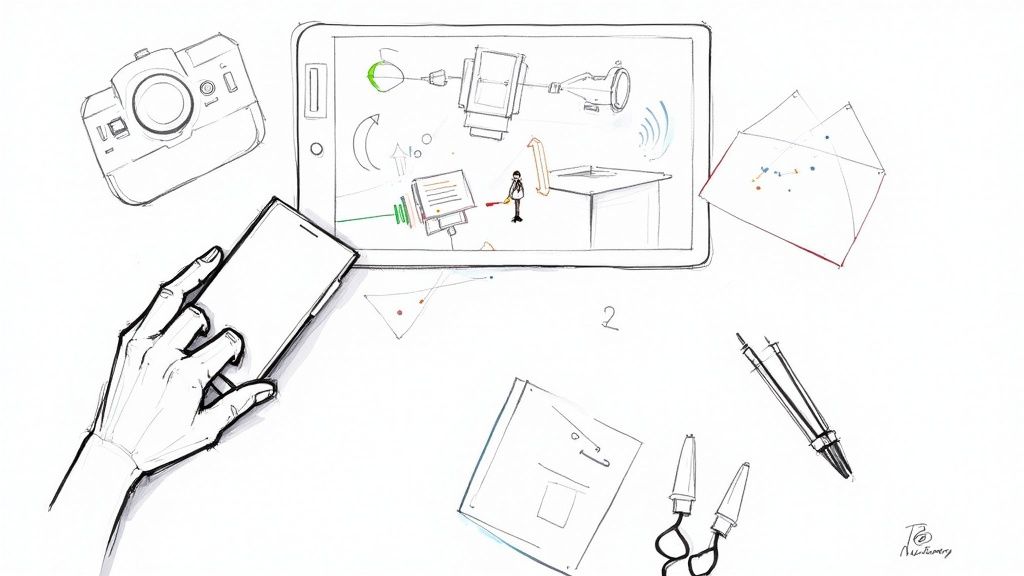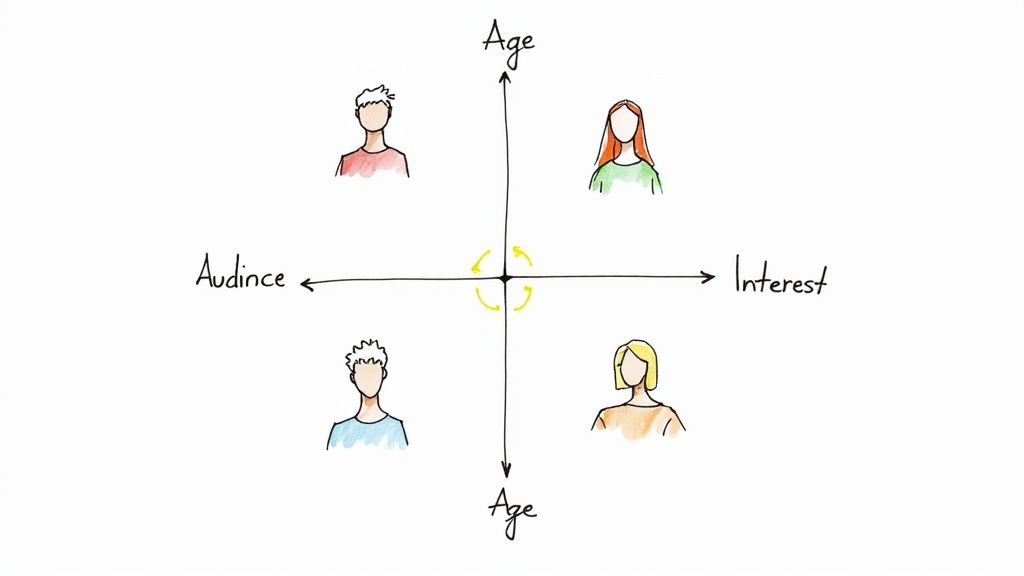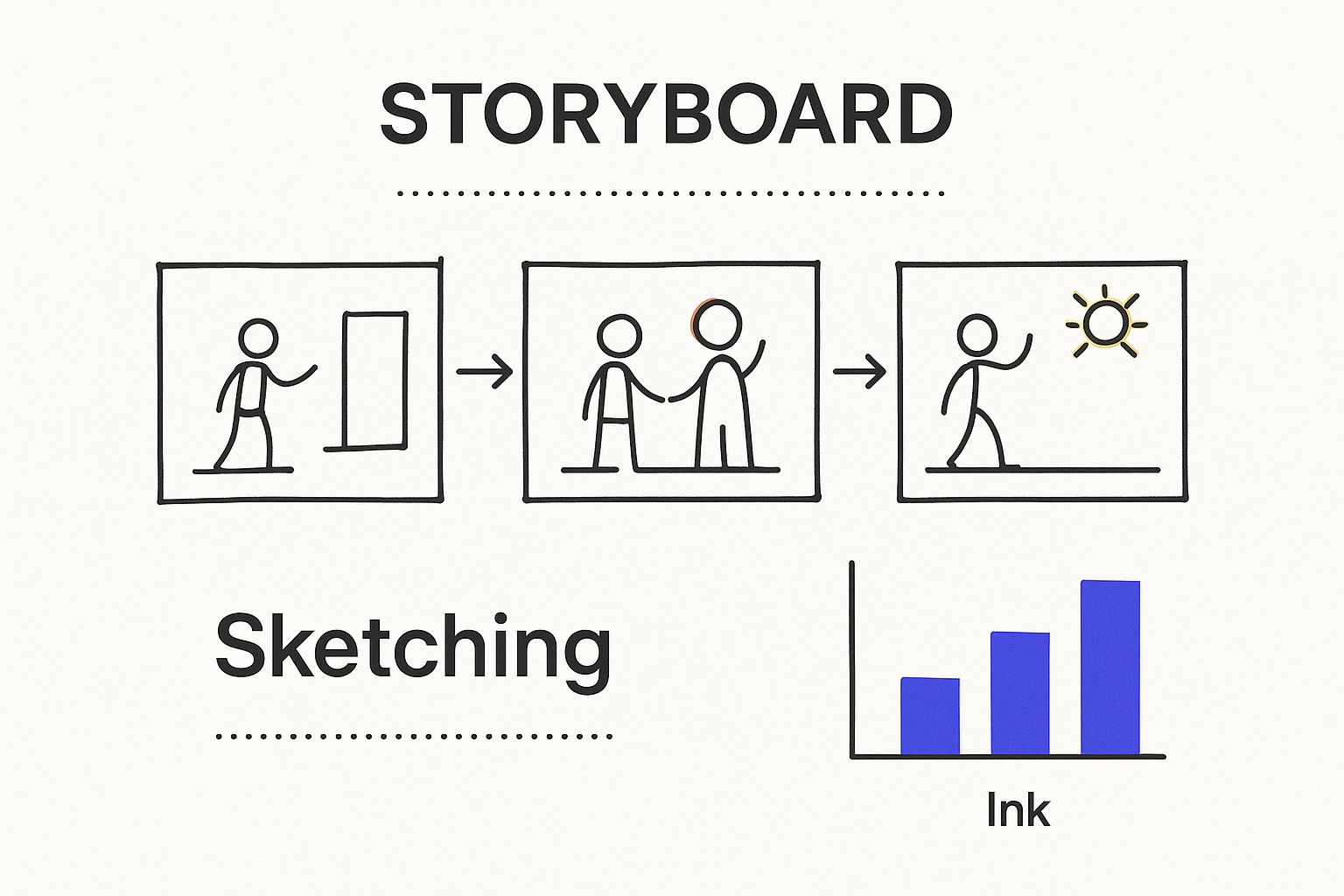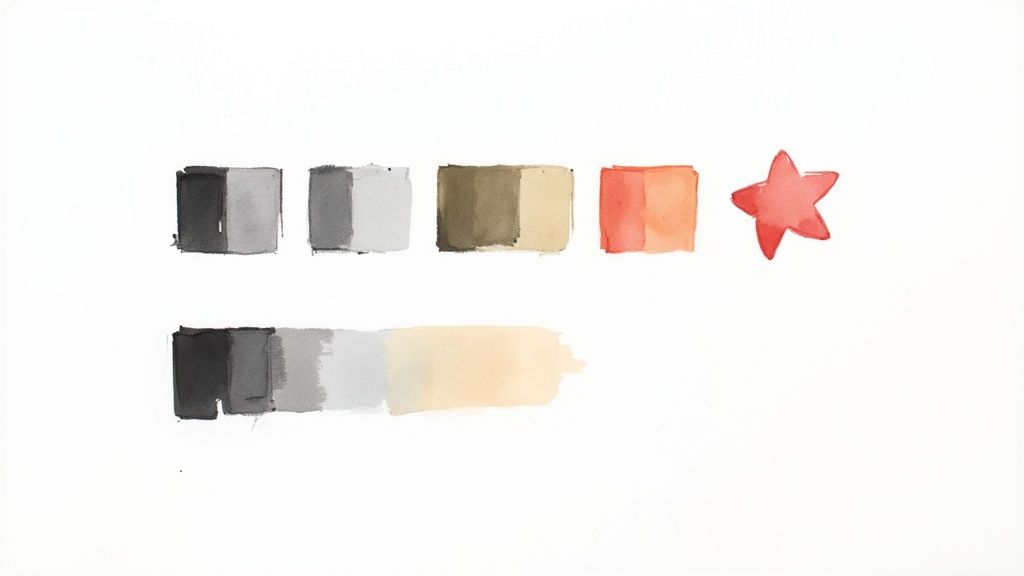How to Create Video Ads That Convert

At its core, making a video ad that actually works is pretty straightforward. You figure out your goal, nail down your audience, write a script that connects, create the visuals, and then get it in front of the right people. Easy, right?
Well, the secret sauce is in the details. Success really boils down to a killer hook in the first three seconds and a call to action that people can't ignore.
Your Blueprint for High-Impact Video Ads
In a world where everyone is fighting for attention, a good video ad doesn't just get seen—it gets remembered. It has the power to stop someone mid-scroll, tell a story that sticks, and push them to make a purchase. But getting those results means moving beyond generic advice and building a practical, repeatable process.
That’s exactly what this guide is for. We're going to walk through the entire journey, from the first spark of an idea to analyzing the final campaign, with a focus on actionable insights that turn your vision into a money-making asset.
Before you jump into production, you need a solid foundation. These are the non-negotiables that will guide every decision you make, from scripting to editing.
Core Components of a Successful Video Ad
| Component | Key Objective | Actionable Tip |
|---|---|---|
| Clear Goal | Define what you want the ad to achieve. | Is it brand awareness, lead generation, or direct sales? Be specific. "Increase sign-ups by 15%" is a better goal than "get more leads." |
| Target Audience | Know exactly who you're talking to. | Create a simple persona. What are their pain points? What kind of humor do they like? Where do they hang out online? |
| The Hook | Grab attention in the first 3 seconds. | Open with a surprising question, a bold statement, or visually jarring imagery. Don't waste time on a slow logo animation. |
| Core Message | Communicate one single, compelling idea. | Don't try to say everything. Focus on the #1 benefit or solution your product offers. Simplicity wins. |
| Call to Action (CTA) | Tell viewers exactly what to do next. | Use clear, direct language like "Shop Now," "Learn More," or "Download the Guide." Make it impossible to misunderstand. |
With these elements defined, you have a clear roadmap. Every piece of your ad should serve these core components, ensuring a focused and effective final product.
Why Video Ads Are a Non-Negotiable
The numbers don't lie. A staggering 89% of businesses are now using video marketing, and for good reason. Marketers aren't just following a trend; they're seeing real, measurable results, with 93% reporting a positive ROI from their video campaigns.
This isn't just about looking good. It’s about driving tangible business outcomes:
- Skyrocketing Brand Awareness: Videos make your brand hard to forget.
- Driving Web Traffic: A great ad is a direct pipeline to your website.
- Generating Qualified Leads: Educate and filter potential customers before they even talk to sales.
- Boosting Direct Sales: Nothing sells a product like seeing it in action.
Embracing AI for Smarter Production
The best part? You no longer need a Hollywood budget or a full-scale production crew to create professional-grade video ads. AI tools are completely changing the game, especially when it comes to one of the most critical elements: audio.
A great video with bad audio will almost always fail. On the flip side, an average video with crisp, professional audio can feel incredibly polished and trustworthy.
This is where a tool like Verbatik becomes your secret weapon. Throughout this guide, we'll show you how its unlimited text-to-speech and voice cloning features can give your ads a consistently high-quality sound. Imagine creating the perfect voiceover for ten different ad variations in minutes, or cloning a specific brand voice to use across all your campaigns.
This approach saves a ton of time and money, cutting out the need for expensive voice actors and studio sessions. To get a feel for how it works, check out our guide on how to make AI-generated videos.
Building a Winning Video Ad Strategy

Before you ever think about hitting "record," let's talk strategy. It's the one thing that separates a video ad that gets results from one that just burns through your cash. A winning ad comes from a solid plan, not just a random creative idea. Rushing into production without this groundwork is like building a house without a blueprint—it’s guaranteed to get messy.
The very first thing you need to do is nail down one clear, measurable goal. Are you trying to drive immediate sales for a new product? Or is this about getting your brand name to stick in the minds of a new audience? Each of those goals demands a totally different creative style, tone, and call to action.
Define Your Objective and Audience
Your goal really does shape every single decision you'll make. An ad meant for brand awareness might lean into storytelling and emotion, but an ad focused on sales has to be direct, packed with benefits, and capped with a clear, urgent CTA.
Once you’ve got your goal, you need to know exactly who you're talking to. And I mean going deeper than just age and location. What are their real-world frustrations? What problems are keeping them up at night that your product can actually solve? When you get their motivations, you can craft a message that genuinely connects.
It's tempting to try and appeal to everyone, but it’s a classic mistake. A video ad built for a specific niche audience will crush a generic one every time. Focus on building a real connection with a smaller, more dedicated group.
With your audience defined, the next piece of the puzzle is figuring out where they hang out online. An ad that kills it on TikTok is probably going to feel awkward and out of place on LinkedIn.
- TikTok & Instagram Reels: Go here for short, snappy, trend-inspired content aimed at younger crowds.
- YouTube: This is your spot for longer stories, how-to videos, and detailed product demos that hook viewers who are actively looking for solutions.
- LinkedIn: The go-to for B2B campaigns. Think professionalism, industry insights, and building corporate trust.
- Facebook: A super versatile platform that’s solid for a wide range of audiences, especially if you're trying to drive local business.
Budgeting for Maximum Impact
Finally, let's talk money. A realistic budget needs to cover both making the ad and getting it in front of people. While slick production is nice, a killer concept with a powerful message can be shot on a modern smartphone. The real secret is setting aside enough budget for distribution to make sure your target audience actually sees your masterpiece.
The shift to digital video is massive and undeniable. By 2025, U.S. companies are expected to pour a staggering $72 billion into digital video ads. That figure is growing three times faster than overall media budgets for a reason—nearly 60% of all video ad spending is now digital as people tune out traditional TV.
This is where AI tools can be a game-changer for your budget. Think about A/B testing different voiceovers—doing that the old-fashioned way is slow and expensive. But by using Verbatik's unlimited text-to-speech and voice cloning, you can spin up dozens of high-quality audio tracks in minutes. This slashes your costs and speeds up your entire workflow, freeing up more of your budget for the ad spend that gets your message to more people. Check out how you can start streamlining your marketing efforts with AI.
Crafting a Script That Captivates and Converts
Every great video ad starts not with a camera, but with a story. The script is truly the engine that drives your entire project—get it right, and you’re halfway there. Get it wrong, and even the slickest production will fall flat. The goal is to build a structure that grabs someone's attention immediately and doesn't let go.
The most reliable framework I’ve seen work time and time again is the classic Hook, Story, Offer. In today's fast-scrolling world, you've got maybe three seconds to stop someone in their tracks. Your hook has to be sharp, surprising, or just plain weird enough to make them pause. Think of a bold question, a shocking statistic, or a visual that makes zero sense at first glance.
With their attention captured, you can gently transition into the story. This is your chance to connect with a pain point they're actually feeling. You introduce your product not as a list of features, but as the hero that solves their problem. The key is to keep it real; the dialogue should sound like a friend giving advice, not a salesperson reading from a brochure.
The Hook, Story, Offer Framework
This isn't just a creative guideline; it's a strategic formula for clarity and impact. Here’s how it breaks down:
- Hook (1-3 seconds): Lead with your knockout punch. This could be your most compelling visual or a statement that piques curiosity. Whatever you do, don’t waste this critical window on a slow-fading logo.
- Story (5-20 seconds): Quickly outline the problem your audience knows all too well. Then, show them how your product or service is the answer. Focus on the transformation—the "before and after" feeling—not just the technical specs.
- Offer (3-5 seconds): End with a crystal-clear Call to Action (CTA). Don't be vague. Tell them precisely what to do next: "Shop Now," "Sign Up," or "Learn More."
Once you’ve got a draft, the next step is to bring it to life with a storyboard. Think of it as a simple comic strip for your ad. This is where you map out each shot, making sure the pacing feels right and catching any awkward moments before you start filming. It saves so much time and headache later.
A simple three-panel storyboard helps you see the ad's flow at a glance, from the initial hook all the way to that final, crucial call-to-action.

This visual blueprint is your best friend for ensuring every single scene has a purpose and moves the viewer closer to your goal.
Planning Your Audio and Voiceover
As you’re writing the script, you should also be thinking about how it’s going to sound. A professional, engaging voiceover can completely elevate an ad, building a layer of trust and authority. This used to be a major bottleneck—hiring voice actors, booking studios, and spending a small fortune. Thankfully, AI has changed everything.
Your script provides the words, but the voiceover delivers the emotion. Getting the tone right is just as important as the message itself.
This is where planning your audio becomes a massive strategic advantage. With a tool like Verbatik, you get access to unlimited text-to-speech, which means you can generate dozens of voiceover options in just a few minutes. Want to test a friendly tone versus an authoritative one? Or hear how it sounds in a different language? You can do it all without adding a cent to your budget.
And if you’re hitting a wall with the writing itself, an AI script writer can be a lifesaver for brainstorming ideas or polishing your dialogue. Better yet, with voice cloning, you can develop a unique and consistent brand voice across all your campaigns. It ensures every ad sounds professional and instantly recognizable, making high-quality production accessible to everyone.
Using AI for Smart Production and Voiceovers
Welcome to the new world of video production, where professional quality is no longer trapped behind a massive budget. Thanks to AI, anyone can create polished video ads without hiring a full production crew. The game has shifted to smart, cost-effective creation, and your audio is the best place to start.
A solid voiceover builds trust and makes your ad feel instantly more credible. But let's be real—hiring voice actors, booking studios, and dealing with endless retakes is a slow, expensive grind. This is where AI completely flips the script on your audio strategy.
Rethink Your Audio with AI Voice Generation
Instead of slapping on a voiceover at the end, plan it from the very beginning. With a tool like Verbatik, you get unlimited text-to-speech, letting you generate perfect audio from your script in just a few minutes. This opens the door to experimenting with different tones, paces, and styles without spending an extra dime.
Let's say you're launching a new tech gadget. You could try out a punchy, energetic voice for a YouTube pre-roll ad, then switch to a calmer, more reassuring tone for a Facebook campaign targeting a different audience. This kind of A/B testing for audio used to be a budget-buster, but now it’s just a few clicks away.
With AI, the biggest barrier to high-quality audio isn't money or access anymore—it's your own creativity. You can produce, test, and tweak your ad's sound until it’s perfect, all inside a single platform.
The technical side of video ads is getting smarter, too. AI is paving the way for better personalization and analytics. In fact, 18% of businesses are already using AI tools for tasks like auto-generating captions and transcripts, which is a huge boost for accessibility and engagement. You can read more about these evolving video ad trends to see where things are headed.
Lock in a Consistent Brand Voice
Consistency is everything when you're building a brand people remember. Your audience should know it's you in an instant, and a unique voice is a huge part of that identity. Verbatik’s voice cloning feature is a game-changer here, letting you create a custom AI voice that perfectly captures your brand’s personality. Every ad will sound distinctively yours.
The process couldn't be simpler:
- Drop in Your Script: Just paste your final script right into the platform.
- Pick or Clone a Voice: Choose from a massive library of realistic AI voices, or use the voice cloning tool to craft your signature sound.
- Tweak and Export: Fine-tune the pitch, speed, and emotion until the delivery is just right, then export the high-quality audio.
This workflow slashes production time and costs. If you want to dig deeper into your options, check out our guide on the best text-to-speech solutions available to find the perfect match for your project.
But it doesn't stop with the voice. AI can handle the rest of your ad’s soundscape, too. Learning how to create sounds with AI can help you quickly generate custom sound effects and ambient tracks that perfectly match your ad's vibe. By combining a powerful AI voiceover with custom-made sounds, you get complete creative control to build an immersive ad that grabs attention and gets results.
Distributing and Optimizing Your Video Ad

You’ve created your video ad, which is a massive win. But don't pop the champagne just yet. The next phase is arguably even more important—getting your ad in front of the right eyeballs and turning those views into actual business. This is where we get into the nitty-gritty of distribution and optimization.
Before you launch, it's all about adding that final layer of polish. Think background music, simple graphics, and especially captions. Little details like these can make a huge difference in engagement, especially since so many people watch videos on mute.
Launching and Testing for Performance
Alright, your ad is polished and ready. Time to send it out into the world. But the worst thing you can do is just "set it and forget it." To really squeeze every drop of value from your budget, you have to be testing. Constantly.
A/B testing is the name of the game here. You'll want to create a few different versions of your ad to see which one your audience clicks with.
Here are a few things I always recommend testing:
- Thumbnails: Does a clean product shot work better than a smiling face? Test it.
- Headlines: Pit a direct, benefit-focused headline against an intriguing question.
- Calls-to-Action (CTAs): See what pulls more clicks: a direct "Shop Now" or a softer "Learn More."
- Voiceovers: Does an upbeat, energetic voice convert better than a calm, authoritative one?
In the past, testing voiceovers was a real headache—expensive, slow, and a logistical nightmare. But with Verbatik, that’s no longer an issue. The platform’s unlimited text-to-speech and voice cloning lets you whip up dozens of top-notch audio tracks in minutes. This makes it dead simple to find the perfect voice for each ad variation without torching your budget.
A/B testing isn't about finding one magical "perfect" ad. It's about building a system of continuous improvement, so every campaign you run is smarter than the last.
Tracking and Optimizing for a Better ROI
Once your ads are live, it’s time to become a data detective. Forget about vanity metrics like total views and focus on the numbers that actually move the needle for your business.
Keep a close eye on these key metrics:
- Click-Through Rate (CTR): What percentage of people are actually clicking on your ad?
- Conversion Rate: Of those who click, how many are taking the action you want them to (like buying or signing up)?
- Cost Per Acquisition (CPA): How much are you spending to land a single new customer?
This data tells a story. For example, a high CTR but a low conversion rate probably means your ad is grabbing attention, but your landing page is dropping the ball. A painfully high CPA could mean your audience targeting is way too broad.
Use these clues to make smart adjustments. You might need to refine your audience, shift your budget, or kill the ads that just aren't performing. If you’re looking for more ways to get your content seen, our guide on content amplification strategies is a great place to start.
Finally, don't forget the technical side. Making sure your video files are lean and load quickly is crucial for performance. Checking out some of the top video compression software for marketers can help ensure your ads play smoothly everywhere, without frustrating delays.
Navigating Common Video Ad Challenges
Diving into your first video ad can feel overwhelming. It’s easy to imagine a mountain of obstacles, from budget constraints to technical headaches, and those fears stop too many good ideas dead in their tracks. The good news? These roadblocks are not only common, but they're also entirely manageable with the right game plan.
Even with video's incredible track record, a surprising number of marketers are still on the sidelines. While 89% of businesses are already in the video marketing game, a recent study pointed to a fascinating reason why others aren't: 37% said they simply didn't know where to start. That beat out lack of time and high costs as the number one barrier. You can see the full breakdown of these marketing hurdles for yourself.
That's exactly why we're here—to give you that starting point and show you how to get from idea to a finished ad, one clear step at a time.
Taming the Budget and Tech Dragons
Let's tackle the two biggest concerns right away: cost and complexity. The old belief that you need a Hollywood-sized budget and a film crew to make a professional ad is completely outdated, especially when it comes to getting great audio.
Traditionally, professional audio meant hiring voice actors and booking expensive studio time, which can chew through your budget before you even start filming. This is where AI tools are a complete game-changer. For example, you can generate a flawless voiceover with a tool like Verbatik without the eye-watering price tag. Its unlimited text-to-speech feature means you can experiment with dozens of tones and styles without ever paying for another take.
The secret to overcoming a tight budget isn't cutting corners—it's using smarter tools. AI-driven audio production delivers professional quality for a fraction of the traditional cost, freeing up your budget for ad spend.
What if you need to maintain a specific brand voice across all your campaigns? The voice cloning feature has you covered. It ensures every single ad sounds consistent and professional, locking in your brand's unique sound. This solves one of the most expensive and time-consuming parts of video production, giving you more creative freedom to nail your message. It’s an approach that puts high-quality video ads within reach for any team, no matter the size or budget.
Your Questions Answered
Still have a few questions swirling around about making video ads? Let's clear those up. Here are some of the most common things people ask when they're getting started.
How Long Should My Video Ad Be?
There's no single magic number—it all comes down to where your ad will live. For the endless scroll of a platform like Instagram, you need to be quick and punchy, so aim for 15-30 seconds.
If you’re running a pre-roll ad on YouTube, your window is even tighter. You've got to make an impression in just 5-15 seconds. Over on TikTok, the sweet spot is usually between 9-15 seconds.
But here's the universal rule: no matter the platform, you absolutely must deliver a killer hook in the first three seconds. That's your only shot to stop someone's thumb and get them to pay attention.
Can I Really Create Good Video Ads on a Small Budget?
You absolutely can. Today's smartphones can shoot incredible 4K video, and there are tons of affordable editing tools out there. The secret to a great ad isn't about having a Hollywood-sized budget; it's about having a sharp, memorable script and a message that connects.
This is also where you can get really smart with your production costs. Instead of shelling out for a voice actor, you can use AI tools like Verbatik to get professional-sounding voiceovers for a tiny fraction of the cost. With its unlimited text-to-speech and voice cloning, you can get top-tier audio without the top-tier price tag.
Your budget doesn't limit your creativity; it just guides your resourcefulness. Focus on a killer script and smart tools, and you can compete with anyone.
What Are the Most Important Metrics to Track?
Don't get bogged down in vanity metrics. The only numbers that truly matter are the ones tied directly to your campaign goal. Everything else is just noise.
Focus on what tells you if you're actually hitting your targets:
- Building Brand Awareness? Keep a close eye on your View-Through Rate (VTR) and Impressions.
- Driving Traffic? It’s all about the Click-Through Rate (CTR) and Cost Per Click (CPC).
- Generating Sales or Leads? The metrics that pay the bills are Conversion Rate and Cost Per Acquisition (CPA).
These are the numbers that give you the real story of what’s working and show you exactly where you need to fine-tune your approach for better results.
Ready to create stunning, professional-sounding video ads without the high cost and complexity? With Verbatik, you get unlimited text-to-speech, instant voice cloning, AI avatars, and a full suite of tools to make production fast and easy. Start creating for free today at verbatik.com.
